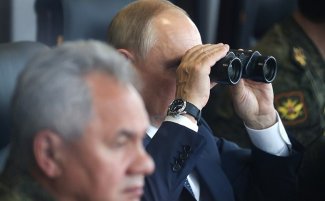Russian army in search of human reserves. Day 414 of the war

There have been no major changes on the front line in recent days, and the main areas of fighting remain Bakhmut, Avdiivka, Marinka and the forest complex near Kreminna. In Bakhmut, the Ukrainian forces are defending themselves in the western part of the town, but are slowly abandoning more buildings under the onslaught of assault troops from the Wagner Group. According to a communiqué from the Ukrainian General Staff, Wagner has lost about 4500 dead and wounded in the town over the past two weeks, but this has not led to a reduction in the intensity of the fighting. A major handicap for the defenders is the rainy weather, which made it significantly harder to bring in supplies and conduct evacuations using the dirt roads between Chasiv Yar and Bakhmut.
The invaders are continuing to shell localities near the border and throughout the frontier zone, using barrel artillery, multi-barrel rocket launchers and, in isolated cases, S-300 missile systems. In Kherson and surrounding towns along the River Dnieper, increased Russian drone activity has been reported in recent weeks; they drop grenades on Ukrainian military or police posts and terrorise the civilian population.
The German government has agreed to provide Kyiv with five Polish MiG-29 aircraft, which originally belonged to the East German army but were taken over by the Bundeswehr after German reunification. In 2003 22 MiG-29Gs were handed over to Poland. At the same time, Prime Minister Mateusz Morawiecki announced that Poland would send more aircraft of this type to Ukraine in the near future, but did not specify their number or when they would be handed over. Spain plans to deliver six Leopard 2A4 tanks to Kyiv by the end of April, and at a later date, another four such tanks when their overhaul has been completed. In addition, Madrid has pledged to hand over 20 armoured personnel carriers, although it has not confirmed which type. Canada, for its part, has announced a new military aid package, including 21,000 assault rifles, 38 machine guns and 2.4 million rounds of ammunition.
Photographs and videos published on social media indicate that equipment whose transfer had not previously been officially announced is also arriving in Ukraine. In recent days, the use by the Ukrainian armed forces of 152mm Hyacinth-B cannon howitzers from Finland (which until recently had 24 cannons of this type) and US Oshkosh M-ATV armoured vehicles has been confirmed.
South Korean media reported that in March Washington reached an agreement with Seoul to loan 500,000 155-mm artillery rounds. This unusual transfer of ammunition came about because South Korea refuses to send arms or ammunition directly to Ukraine, as its laws do not allow the export of armaments to conflict areas. The loan of South Korean artillery shells will allow the United States to provide Kyiv with ammunition of its own manufacture while maintaining the necessary reserve for the US Army.
According to the Ukrainian General Staff, Russia plans to begin serial production of Kh-50 cruise missiles in June so it can intensify its attacks on Ukraine in the autumn. Air Force Command spokesman Yuri Ihnat said the enemy has used more than 850 cruise missiles of various types since 11 September last year. The decision to produce Kh-50s, which were developed back in Soviet times, may be because it is a cheaper and less complicated weapon. Ihnat expressed hope that producing it will remain difficult if the West maintains its sanctions regime.
On 12 April, the Ukrainian interior ministry announced the start of the formation of another brigade of the so-called ‘offensive guard’ to be called ‘Karta’. This will be the seventh light infantry unit to be included in the National Guard; the other two operate as parts of the National Police and the National Guard. ‘Karta’ will admit individuals with extensive experience in combat operations, some of whom will have operated in the Kharkiv area at the beginning of the invasion, and later in Bakhmut. The Armed Forces of Ukraine are also recruiting for the 3rd Assault Brigade; its command staff includes soldiers who fought in the Azov Regiment in the past.
Ukraine’s defence minister Oleksiy Reznikov has announced that the secret US military documents leaked to the press contain a mix of true and false information. In his view, the leak is an operation which is of benefit to Russia and its allies. In turn the head of military intelligence, Kyrylo Budanov, expressed confidence that the leak would not damage relations between Ukraine and the US, and will not significantly affect the course of offensive operations.
On 12 April, Ukraine’s prime minister Denys Shmyhal asked during a meeting with US Defence Secretary Lloyd Austin in Washington for F-15 and F-16 fighters and long-range missiles to be delivered. He pointed out that this was one of the conditions for winning the war and reducing casualties. Austin did not respond to this appeal, but promised to increase the production of military equipment for Ukraine.
A day earlier Rob Joyce, director of cyber security at the US National Security Agency, warned that Russian hackers are consistently breaking into surveillance cameras installed at Ukrainian public facilities. In this way they are acquiring data on the movement of military equipment and supply columns. Joyce added that the Russians are also hacking US arms and logistics companies in a bid to gain data concerning weapons supply chains to Ukraine.
In Bucharest on 13 April, Ukraine’s foreign minister Dmytro Kuleba presented a proposal to integrate his country’s air defence systems with those of NATO allies in the Black and Baltic Seas. According to Kuleba, the war has proven that the region’s security cannot be split up by individual countries, and the missiles Russia fires toward Ukraine also threaten Poland, Romania and Moldova. As the minister put it, the idea of Ukraine becoming part of the European Defence Initiative is also worth considering.
On 12 April, the Russian Federation Council completed work on amendments to the law entitled ‘On Military Duty and Military Service’. Their purpose is to create a functional mobilisation system and lower the age of candidates for contract service to 18. A unified electronic registry of persons subject to compulsory military service will be created, and the receipt of summonses to appear before a military commission will be registered in electronic form on the Gosusluga website. These moves are aimed at removing the shortcomings that disrupted last autumn’s mobilisation. The changes are restrictive in nature: simply posting of a summons on someone’s personal account on the website, or the transmission of the document to someone else resident at the same address, will be considered as delivery of the summons. According to the amendment, citizens will not be allowed to leave Russia from the moment they receive the summons until they appear before the commission. Residents abroad who have received the document will be required to return to Russia. In the case of evading military duty, the person summonsed may lose his driver’s license, the ability to register as self-employed or take out loans after 20 days, and be prevented from trading in real estate. New rules for admission into contract service have also been introduced; Russians aged 18 and over will be able to enter into contracts as soon as they are called up to the army (hitherto at least three months of military service had been required).
Commentary
- The tightening of Russia’s mobilisation regime had been announced back last year after the chaos in military records was revealed. The lack of up-to-date data on who is eligible for military service adversely affected the autumn mobilisation plan. However, it is not a foregone conclusion that the introduction of a unified military register in electronic form will be completed quickly. The process requires the processing and verification of masses of individual data (in 2022, about 20 million men aged 20–39 were included in the reserves for mobilisation). On the other hand, the amendments to the Law on Military Obligation are expected to put pressure on those included in the reserve not to attempt to evade their service, under the threat of severe administrative penalties. The new measures, such as allowing those 18 years of age or older to conclude an immediate contract, indicate that a form of ‘silent mobilisation’ is underway in Russia, and that Russian losses in units operating in Ukraine are being hastily replaced in this way.




